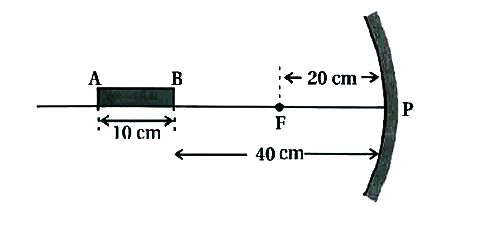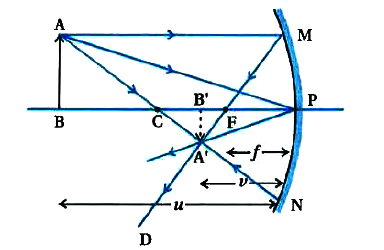The image of a small electric bulb fixed on the wall of a room is to be obtained on the opposite wall 3m away by means of a large convex lens. What is the maximum possible focal length of the lens required for the purpose?Solution in Gujrati
The minimum distance between object and image should be 4f to get real image on wall.
∴u+v=4f
u=v=3m
∴3=4f
∴f=34=0.75 m
⇒ Only for information :
⇒ Suppose the object distance is u,
∴1v−1u=1f

⇒ For convex lens
u is negative so, 1v+1u=1f
but u + v = d (is give)
∴v=d−u
∴1d−u+1u=1f
∴u+d−uu(d−u)=1f
∴u2−ud+fd=0
⇒ This is the quadratic equation for variabel u. It.s roots are as given below :
u=d±√d2−4fd2
But u = v
∴v=d±√d2−4df2
⇒ For real image v is positive Hence, d2−4df≥0ord2≥4df
∴d>4f
Hence, to obtain the image , the miniumum value of d should be 4 f.
∴d=4fandu+v=d
Topper's Solved these Questions
- RAY OPTICS AND OPTICAL INSTRUMENTSBOOK - KUMAR PRAKASHANCHAPTER - RAY OPTICS AND OPTICAL INSTRUMENTSEXERCISE - SECTION-B (NUMERICALS)(NUMERICAL FROM .DARPAN. BASED ON TEXTBOOK )
12 Videos
- RAY OPTICS AND OPTICAL INSTRUMENTSBOOK - KUMAR PRAKASHANCHAPTER - RAY OPTICS AND OPTICAL INSTRUMENTSEXERCISE - SECTION-C (NCERT EXEMPLAR SOLUTION) (MULTIPLE CHOICE QUESTIONS (MCQs))
16 Videos
- RAY OPTICS AND OPTICAL INSTRUMENTSBOOK - KUMAR PRAKASHANCHAPTER - RAY OPTICS AND OPTICAL INSTRUMENTSEXERCISE - SECTION-B (NUMERICALS)(NUMERICAL FROM TEXTUAL ILLUSTRATIONS)
17 Videos
- MOVING CHARGES AND MAGNETISMBOOK - KUMAR PRAKASHANCHAPTER - MOVING CHARGES AND MAGNETISMEXERCISE - SECTION D (MCQs ASKED IN COMPETITIVE EXAMS)
34 Videos
- SAMPLE QUESTION PAPER BOOK - KUMAR PRAKASHANCHAPTER - SAMPLE QUESTION PAPER EXERCISE - PART-B SECTION-C
5 Videos
Similar Questions
As shown in the figure, a thin rod AB of length 10 cm is placed on the principal axis of a concave mirror such that it.s end B is at a distance of 40 cm from the mirror. If the focal length of the mirror is 20 cm, find the length of the image of the rod

View SolutionA ray of light incident at an angle θ on a refracting face of a prism emerges from the other face normally. If the angle of the prism is 5∘ and the prism is made of a material of refractive index 1.5, the angle of incidence is
View SolutionSuppose that the lower half of the concave mirror.s reflecting surface as shown in figure is covered with an opaque (non-reflective) material. What effect will this have on the image of an object placed in front of the mirror ?

View SolutionElectric charge Q having mass M moves on a circular path of radius R with velocity →v, perpendicular to uniform magnetic field B. When a particle completes one revolution, work done by the field is _______
View SolutionTwo charges –q and +q are located at points (0, 0, –a) and (0, 0, a), respectively.
(a) What is the electrostatic potential at the points (0, 0, z) and (x, y, 0) ?
(b) Obtain the dependence of potential on the distance r of a point from the origin when r/a>>1 .
(c) How much work is done in moving a small test charge from the point (5,0,0) to (–7,0,0) along the x-axis? Does the answer change if the path of the test charge between the same points is not along the x-axis?
View SolutionThe image of a small electric bulb fixed on the wall of a room is to be obtained on the opposite wall 3m away by means of a large convex lens. What is the maximum possible focal length of the lens required for the purpose ?
View Solutionकिसी कमरे की एक दीवार पर लगे विधुत बल्ब का किसी बड़े आकर के उत्तल लेंस द्वारा 3 मी दूरी पर स्थित सामने की दीवार पर प्रतिबिम्ब प्राप्त करना है । इसके लिए उत्तल लेंस की अधिकतम फोकस - दूरी क्या होनी चाहिए ?
View SolutionA body is located on a wall. Its image of equal size is to be obtained on a parallel wall with the help of a convex leng. The lens is placed at a distance d ahead of second wall, then the required focal length will be:
View Solutionकिसी कमरे की दीवार पर लगे विधुत बल्ब का किसी बड़े आकार के उत्तल लेन्स द्वारा 3 मीटर दूरी पर स्थित सामने की दीवार पर प्रतिबिम्ब प्राप्त करना है| इसके लिए उत्तल लेन्स की अधिकतम फोकस दूरी क्या होनी चाहिए ?
View SolutionThe image of a small electric bulb fixed on the wall of a room is to be obtained on the opposite wall 3m away by means of a large convex lens. What is the maximum possible focal length of the lens required for the purpose ?
View Solutionकिसी कमरे की एक दीवार पर लगे विद्युत् बल्ब का किसी बड़े आकार के उत्तल लेंस द्वारा 3.6 m की दुरी पर स्थित सामने की दीवार पर प्रतिबिम्ब प्राप्त करना है | इसके लिए उत्तल लेंस की अधिकतम फोकर - दुरी क्या होनी चाहिए ?
View SolutionThe image of a small electric bulb fixed on the wall of a room is to be obtained on the opposite wall 3m away by means of a large convex lens. What is the maximum possible focal length of the lens required for the purpose ?
View SolutionThe image of a small electric bulb fixed on the wall of a room is to be obtained on the opposite wall 3m away by means of a large convex lens. What is the maximum possible focal length of the lens required for the purpose?
View SolutionThe image of a small electric bulb fixed on the wall of a room is to be obtained on the opposite wall 3m away by means of a large convex lens. What is the maximum posible focal length of the lens required for the purpose ?
View SolutionThe image of a small electric bulb fixed on the wall of a room is to be obtained on the opposite wall 3m away by means of a large convex lens. What is the maximum possible focal length of the lens required for the purpose?
View SolutionThe image of a small electric bulb fixed on the wall of a room is to be obtained on the opposite wall 3m away by means of a large convex lens. What is the maximum possible focal length of the lens required for the purpose?
View Solution
